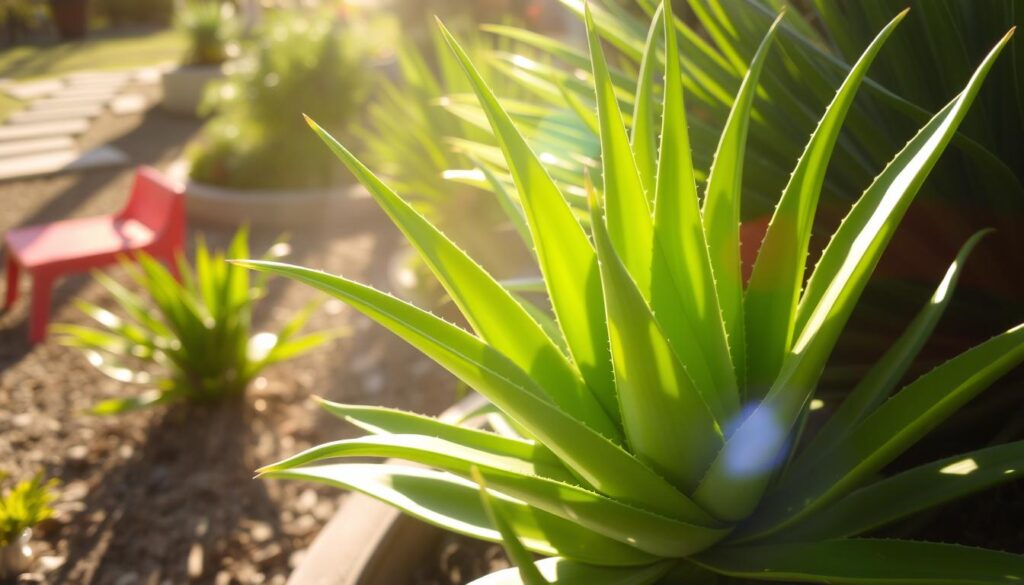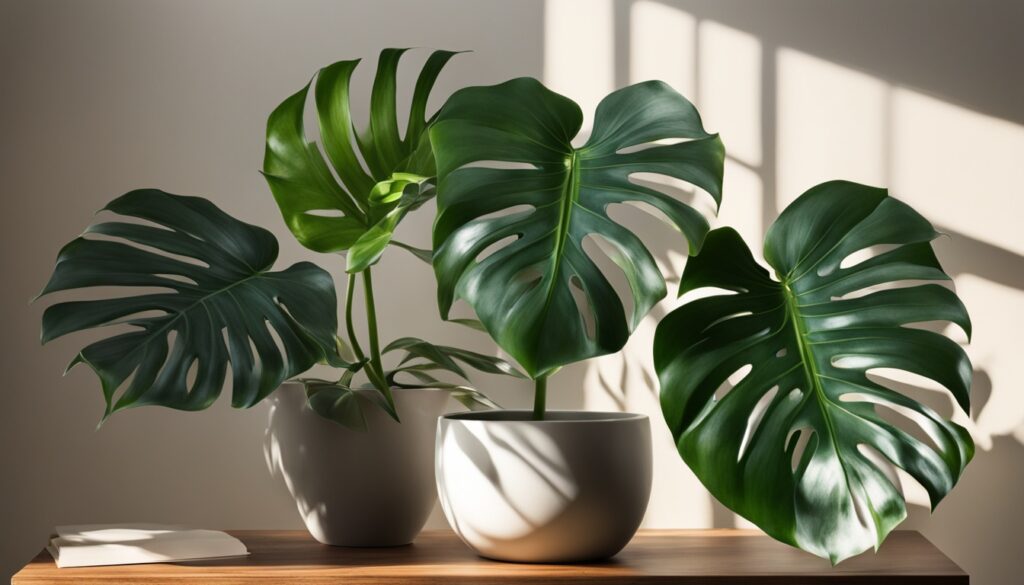The aloe vera plant is a favorite among gardeners and homeowners. But, do they really need sunlight? This guide will show you how much sunlight aloe vera needs, how to care for it, and how it grows. You’ll learn to grow a healthy aloe vera in your home.
Key Takeaways
- Aloe vera plants thrive in bright, indirect sunlight for 6 hours or more per day.
- They can tolerate some direct sun exposure but may sunburn if moved suddenly from shade to direct light.
- Aloe vera plants prefer temperatures between 55-80°F (13-27°C) and are not sensitive to humidity levels.
- Proper watering, soil, and pot selection are crucial for maintaining healthy aloe vera plants.
- Aloe vera gel has been used for centuries to soothe burns, irritation, and promote skin health.
The aloe vera plant is loved for its fleshy leaves and soothing gel. To get the most out of it, knowing its sunlight needs is important. We’ll look at the best growing conditions, care tips, and the aloe vera’s versatility in this guide.
Does your aloe vera plantneed more or less sunlight than you thought
Understanding Aloe Plants: Origins and Characteristics
Aloe plants are known for their unique succulent leaves and many varieties. They come from the sub-Saharan regions of Africa, the Arabian peninsula, and the Indian Ocean islands. These plants are great at surviving in dry places, showing off different leaf patterns, colors, and growth styles.
Native Habitats and Growth Patterns
Aloe vera plants live in rocky, dry areas at high altitudes. They have shallow roots and can grow up to three feet tall. Their thick leaves help them store water, making them perfect for dry environments.
Physical Features of Aloe Plants
Aloe plants have leaves that grow in a rosette shape. These leaves can be green, blue-green, or have cool patterns. Their leaves are thick and smooth, with edges that can be sharp or soft. Some aloes also have tall stalks with small, bell-shaped flowers, making them even more beautiful.
Common Varieties for Home Growing
- Tiger Aloe (Aloe variegata): A compact variety with striking, striped leaves
- Lace Aloe (Aloe aristata): Known for its delicate, lace-like leaf markings
- Blue Elf Aloe (Aloe ‘Blue Elf’): A dwarf variety with blue-green, spoon-shaped leaves
These and other aloe varieties are great for indoor and outdoor aloe vera plant care. They add beauty and adapt well to different growing conditions.
Does an Aloe Plant Need Sunlight
Aloe plants are known for their soothing properties and easy care. They need about six hours of direct sunlight daily to thrive. It’s important to introduce them to intense light slowly to prevent sunburn and damage.
While aloe plants love sunlight, they can handle some shade. In hot climates, they even prefer indirect light. Getting enough sunlight helps them stay compact and prevents weak growth. Without enough light, their leaves may sag and become creased.
To ensure your aloe plant gets the right sun, follow these tips:
- Put aloe plants in a south-facing window or a spot with at least 6 hours of direct sunlight per day.
- If your aloe gets less than 6 hours of direct sun, add bright, indirect light to meet its needs.
- Slowly get your aloe used to more sunlight to avoid sunburn, especially when moving it outdoors for the summer.
By giving your aloe the right sunlight, it will grow vibrant and compact. You can also use it for natural skin soothing and air purification.
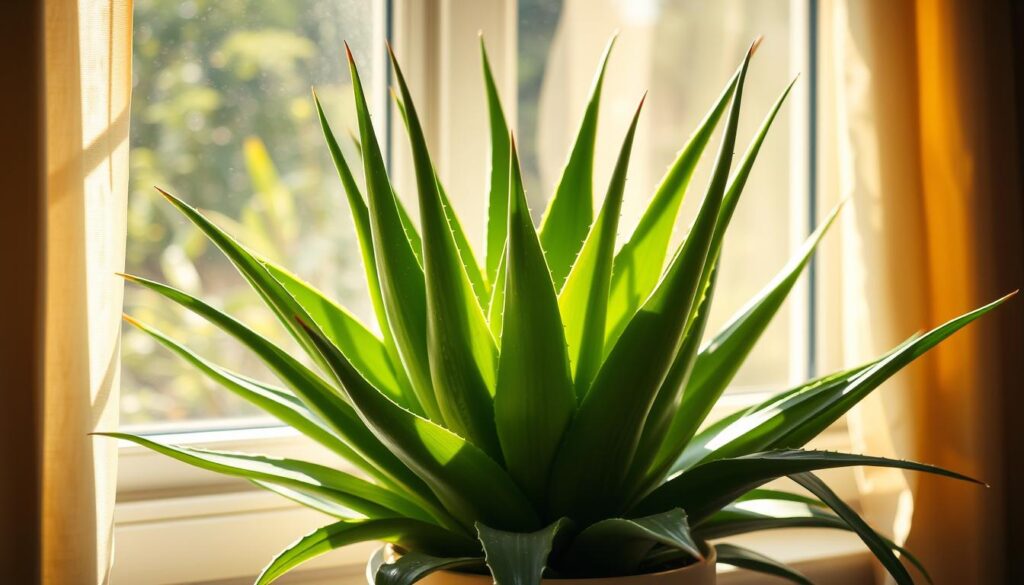
“Aloe plants are sun-loving succulents that require about six hours of direct sunlight daily for optimal growth and health.”
Optimal Light Conditions for Indoor Aloe Plants
Aloe plants love the sun, thriving in bright, indirect sunlight. Indoors, place them near south or west windows. This ensures they get 6-12 hours of light each day.
Direct vs Indirect Sunlight Requirements
Aloes can handle some direct sunlight but avoid too much. Direct rays can cause leaf scorch and dehydration. Bright, indirect light is safer, letting the plant photosynthesize without damage.
Window Placement Strategies
Placing your aloe near a sunny window is crucial for its health. If natural light is lacking, use artificial lighting. Keep it 6-12 inches above the plant for 14-16 hours a day.
Signs of Inadequate Light Exposure
When aloes don’t get enough light, they show signs. Look for:
- Stretched, leggy growth
- Weak, floppy stems
- Loss of the plant’s compact, rosette form
Watch your aloe closely and adjust its light as needed to avoid these problems.
“Aloes need a minimum of six hours of direct sunlight per day for successful indoor cultivation.”
Protecting Aloe from Excessive Sun Exposure
Aloe plants need sunlight, but too much can cause sunburn. It’s important to slowly get them used to more sunlight. Brown or white patches on leaves are signs of sunburn.
To keep your aloe safe, use sheer curtains or blinds to soften sunlight. If it’s outside, give it shade when it’s hottest. This is especially true in areas with very strong summer sun.
The Short-Leaved Aloe can handle some direct sun but prefers indirect light. South-facing windows give it the most sunlight, so watch its exposure closely.
Seasons can change how you care for your aloe. Longer summer days can cause sunburn if it’s too close to windows. Try to place your aloe where it gets 6-8 hours of sunlight a day for best growth.
Artificial Lighting Solutions
If sunlight is scarce, use LED grow lights or fluorescent tubes. These should have a color temperature of 6,000-7,500 Kelvin. Keep the lights 6-12 inches from the plant and light it for 14-16 hours a day.
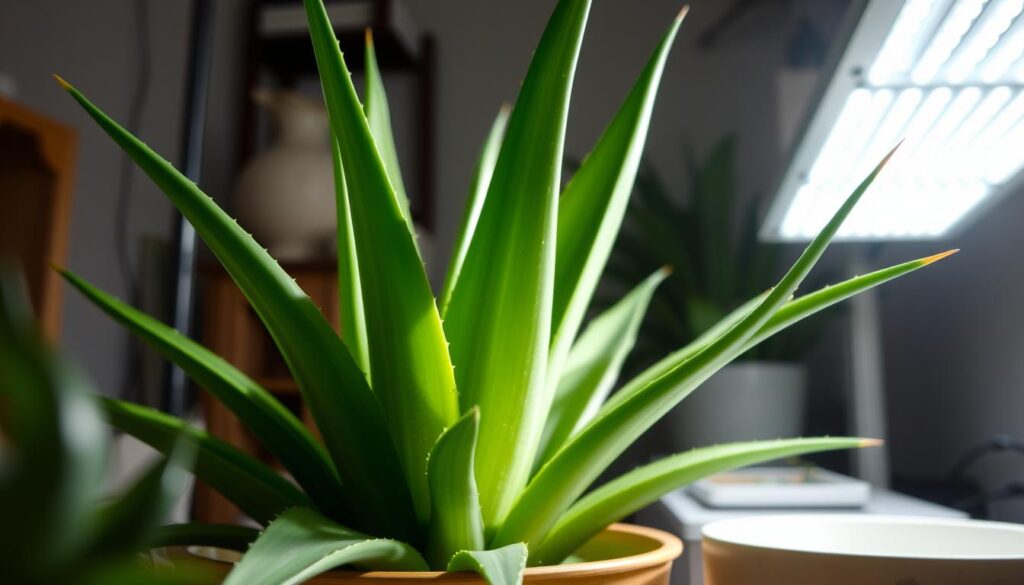
“Aloe vera plants should get at least 6 hours of direct sunlight daily when outside. Not enough light can make leaves pale, yellow, or brown and cause them to grow too long.”
By managing your aloe’s light and slowly adjusting it, you can help it grow well. This way, it won’t get sunburned or stuck in too much shade.
Temperature Requirements for Healthy Growth
Aloe vera plants love warm, dry places. They grow best in certain temperatures. Knowing these helps keep your aloe plant happy and healthy.
Ideal Temperature Ranges
Aloe vera plants do well in daytime temperatures of 60-75°F (15-24°C). At night, they like it cooler, around 50-60°F (10-15°C). Keeping a 10-degree difference between day and night is key for their growth.
Managing Seasonal Temperature Changes
In winter, protect your aloe from cold drafts and chilly windows. In summer, keep it away from hot south-facing windows. Move the plant with the seasons to match your home’s temperature. This helps with aloe vera plant care and growing aloe plants indoors.
“Aloe vera plants thrive on a 10-degree temperature fluctuation between day and night, making them well-suited for indoor environments with consistent, moderate temperatures.”
By keeping the right temperature, your aloe vera plant will grow well and look great all year.
Proper Watering Techniques for Aloe Plants
Caring for aloe plants is all about finding the right balance with water. Aloe vera plants prefer to be dry and should be watered well but not too often. It’s important to let the soil dry out completely before watering again.
In spring and summer, when your aloe is growing, water it every 2-3 weeks. But in winter, cut back on watering to avoid root rot. Never let the aloe sit in standing water, and make sure to avoid getting water on the leaf rosette.
- Use well-draining pots and soil to avoid water stagnation.
- For sensitive aloe varieties, consider using rainwater or purified water to prevent fluoride damage.
Proper watering is key to keeping your aloe plant healthy. By knowing when your aloe needs more or less water, you can make sure it stays strong. This way, it can keep giving you its healing benefits.
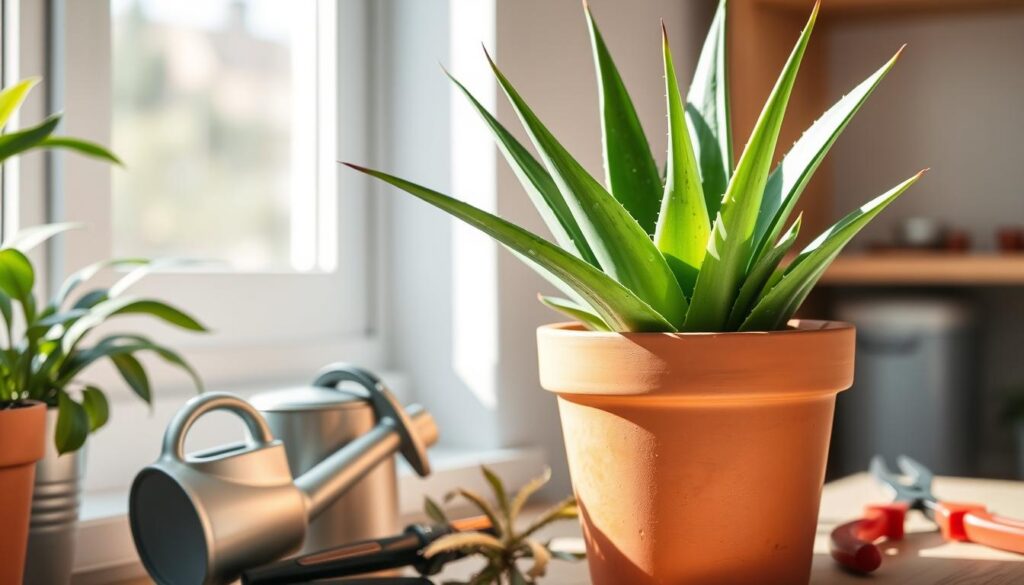
“Aloe vera plants are not likely to flower indoors in the UK due to insufficient warmth.”
Aloe vera plants can grow in many conditions, but they need specific care with water. By following these tips, you can keep your aloe plant looking great. It will continue to offer its many benefits for years.
Soil Requirements and Potting Guidelines
To grow healthy aloe vera plants indoors, the right soil and potting setup are key. These plants do well in soil that drains well and lets their roots breathe.
Best Soil Mixtures for Aloe
For top results, mix equal parts potting soil, peat, and sand or perlite. This mix drains well and holds nutrients for aloe vera. You can also use commercial cactus or succulent mixes, but avoid those with fertilizers already added.
Choosing the Right Pot
Aloe vera plants like pots with drainage holes. Terra cotta or clay pots are great because they let the soil dry faster. Make sure not to bury the stem too deep to avoid stem rot.
| Pot Size | Recommended Use |
|---|---|
| 4-inch | Commonly used for indoor houseplant trade |
| 6-inch | Commonly used for indoor houseplant trade |
| 1-gallon | Commonly used for outdoor landscaping |
| 5-gallon | Commonly used for outdoor landscaping |
With the right soil and pot, your aloe vera plant care will thrive. This ensures healthy growth and beautiful leaves.
Essential Nutrients and Fertilization Schedule
Caring for aloe plants is all about finding the right balance with fertilization. These hardy succulents don’t need much food to grow well. They do best when they get the right nutrients during their growing season and rest in the winter.
To keep your aloe plants healthy, use a balanced organic fertilizer. Dilute it to half strength and feed them once every one to three months from March to September. Stay away from fertilizers high in nitrogen, as they can harm your plants.
| Nutrient Ratio | Recommended for Aloe Vera |
|---|---|
| NPK Ratio | 1-1-1 or 2-1-1 |
| Inorganic Fertilizers | 4-4-6, 20-20-20, 10-10-8 |
| Organic Fertilizers | Fox Farm Big Bloom, Espoma Organic Flower-tone 3-4-5 |
Don’t fertilize your aloe plants from October to February. This lets them rest and recover, as they don’t need much food during this time.
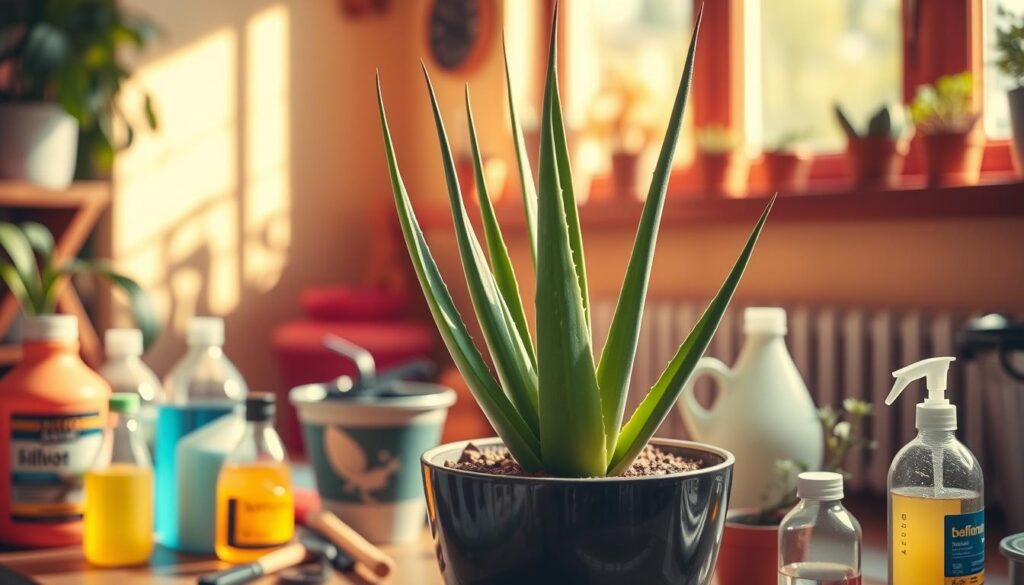
Proper care for aloe plants is about finding the perfect balance. By following these guidelines, you’ll give your aloe plants the nutrients they need. And they’ll get to rest and recharge during the cold months.
Common Growth Problems and Solutions
Aloe vera plants are easy to care for, but sometimes they face growth problems. These issues include leaf drooping, stretching, and discoloration. They often happen because of too little light, too much water, or poor soil.
Identifying Growth Issues
Leaf drooping, or “aloe flop,” means the plant needs more sunlight. Aloe leaves grow tall when they get more light. If leaves turn pale or get brown and crispy, it might be because of too much water or not enough light.
Other signs of trouble include wilting, shriveling, and a soft texture. Root rot, with brown and mushy roots, happens when the soil is too wet. A moldy smell can also mean too much water or bad drainage.
Treatment Methods
- Adjust light exposure: Move the aloe plant to a brighter location with more indirect sunlight.
- Review watering practices: Allow the soil to dry out between waterings and ensure proper drainage.
- Improve soil and pot conditions: Use a well-draining potting mix and a container with adequate drainage holes.
- Manually remove pests: Use alcohol-dipped cotton swabs to get rid of mealybugs or other infestations.
- Prune unhealthy leaves: Carefully remove any damaged or discolored leaves to encourage new growth.
- Repot the plant: Transplant the aloe into a new container with fresh, well-draining soil every 2-3 years.
By quickly fixing these common problems and following good aloe vera plant care guidelines, you can help your aloe stay healthy and vibrant.
Seasonal Care Adjustments
Caring for your aloe plant changes with the seasons. In spring and summer, water more often and give it direct sunlight. This helps it grow like it would outdoors. In fall and winter, water and fertilize less but keep it lighted well to avoid stress.
Keep your aloe plant away from cold drafts in winter. It can’t handle frost or temperatures under 40°F. Move it around your home to match the changing light and temperature all year.
- In spring and summer, increase watering frequency and provide more light
- During fall and winter, reduce watering and fertilization, but maintain light exposure
- Protect plants from cold drafts in winter
- Move plants to different locations to accommodate changing light and temperature
By following these aloe plant care tips, your aloe plant will stay healthy and look great all year.
| Season | Watering | Fertilization | Light |
|---|---|---|---|
| Spring/Summer | Increase frequency | Maintain regular schedule | Provide more direct sunlight |
| Fall/Winter | Reduce watering | Reduce or stop fertilization | Maintain adequate light exposure |
“Aloe vera is a resilient plant, but it requires thoughtful seasonal care adjustments to thrive indoors or outdoors. Following these guidelines will ensure your aloe plant remains healthy and vibrant year-round.”
Propagation Methods for Aloe Plants
Aloe plants are tough and can grow well with little care. One great way to grow more aloe plants is through propagation. Whether you’re growing aloe plants indoors or outside, knowing how to propagate them is key. It helps you make new, healthy aloe plants from the original one.
Handling Aloe Pups
Aloe plants grow offsets, or “pups,” at the base. These pups can be separated and replanted to make new aloe plants. Look for pups that are 2-3 inches tall. Gently dig them out, keeping some roots.
Let the cut end dry and form a callus for a few days. Then, plant the pup in a potting mix that drains well.
Propagation Timeline
The best time to propagate aloe plants is in spring and summer. This is when they grow the most and root quickly. Expect the aloe pups to root in 4-6 weeks with enough light and proper care.
Using a rooting hormone on the cut end can help roots grow faster. Once the roots are established, slowly introduce the new plant to more light and regular watering. This ensures it keeps growing well.
“Propagating aloe plants is a rewarding way to expand your collection and share these versatile succulents with friends and family.”
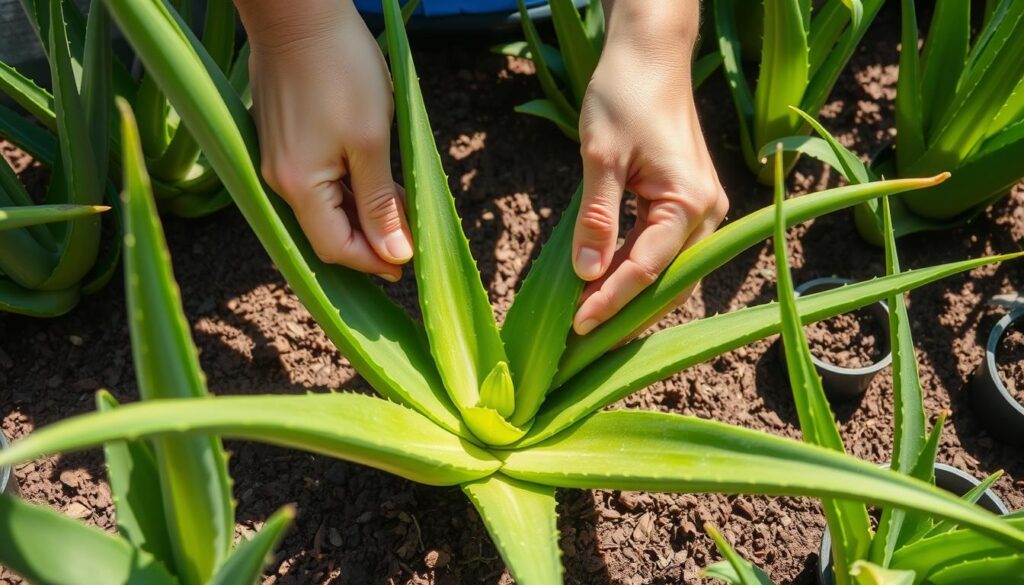
By following these simple steps, you can easily grow more aloe plants. Enjoy their air-purifying benefits and soothing gel for skin care. With patience and care, your aloe plant collection can thrive indoors and outdoors.
Signs of a Healthy Aloe Plant
To keep your aloe plant thriving, it’s key to know the signs of its health. A healthy aloe shows several important traits. These traits show it’s growing well and being well cared for.
The leaves of a healthy aloe are plump and firm. They are a bluish-green or grey-green color. The leaves grow upright or slightly outward, forming a beautiful rosette shape. New growth comes from the center, showing the plant is growing steadily.
A strong root system and tall flower stalks are signs of a mature, healthy aloe. Also, no pests, diseases, or discoloration mean the plant is in top shape.
- Plump, firm leaves with a bluish-green or grey-green color
- Upright or slightly outward-growing leaves in a rosette pattern
- Steady, new growth emerging from the center of the plant
- Vigorous root system
- Occasional production of tall flower stalks
- No signs of pests, diseases, or discoloration
By watching for these signs, you can make sure your aloe plant gets the right aloe plant care tips and aloe light conditions. This will help it thrive and offer its many benefits.
Remember, keeping a close eye on your plant and adjusting its care as needed is crucial. This will help your aloe plant stay healthy and live a long life.
Managing Pests and Diseases
Aloe vera plants can get pests and diseases, but you can keep them healthy. Common pests include mealybugs and aloe mites. These can damage your plants if not treated. To fight mealybugs, use rubbing alcohol and remove them by hand.
Aloe mites cause warty growths. Remove and destroy any infected plants to stop the problem from spreading.
Root rot from too much water is another issue. Soft, discolored leaves are a sign. Make sure your plants drain well and don’t overwater. Check your plants often for pests or diseases and act fast if you find any.
With a good plan for managing pests and diseases, your aloe vera plants will thrive. Enjoy their vibrant, healthy growth with caring for aloe plants and aloe vera plant care.
Integrated Pest Management for Aloe Vera Plants
Using an Integrated Pest Management (IPM) approach is key. It involves monitoring, identifying, and deciding on control methods. This includes biological, cultural, and chemical solutions.
- Regularly check your plants for pests or diseases. Use tools like sticky traps and magnifying glasses to help identify them.
- Encourage beneficial insects, like ladybugs and lacewings, to control pests naturally.
- Use cultural practices, such as good air circulation and rotating plants, to prevent pests.
- Try organic pest control first, like neem oil and insecticidal soaps, before using chemicals.
Preventing Pest and Disease Issues
To keep your aloe vera plants healthy, take proactive steps. Make sure they get enough sunlight and have well-drained soil. Proper watering and fertilizing also help them fight off pests and diseases.
| Pest/Disease | Symptoms | Treatment |
|---|---|---|
| Spider Mites | Discoloration and stippling on leaves | Water, insecticidal soap, neem oil, or miticides |
| Scale Insects | Bumps on stems or leaves | Scraping off scales or applying horticultural oil |
| Fungus Gnats/Fruit Flies | Harm to roots | Letting soil dry out or using soil drench with insecticides |
| Mealybugs | White, fluffy masses | Rubbing alcohol or neem oil |
By using a detailed pest and disease management plan, you can keep your aloe vera plant care and caring for aloe plants healthy for a long time.
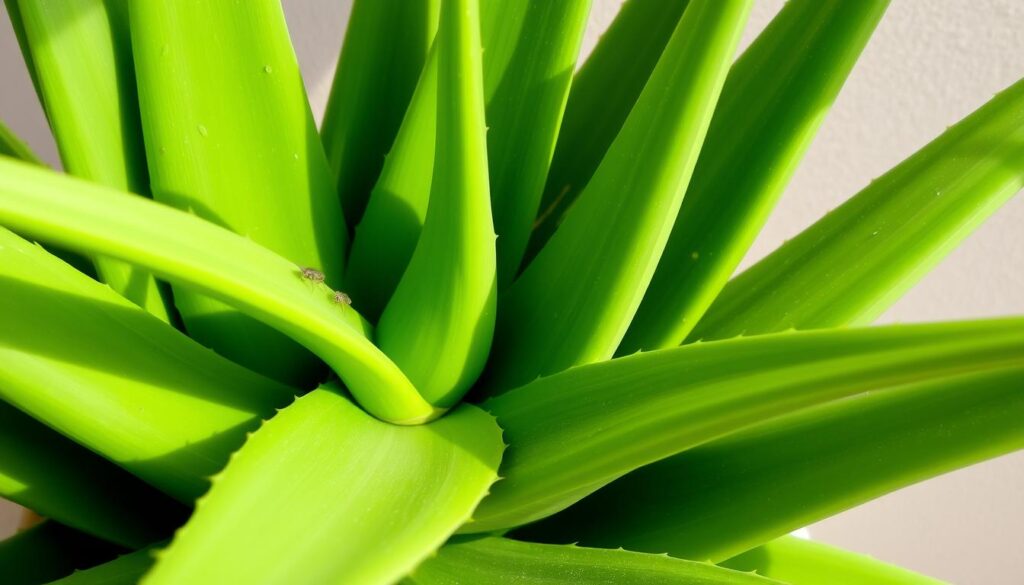
Indoor vs Outdoor Aloe Care
When growing aloe plants, the environment matters a lot. Whether indoors or outdoors, knowing their light, temperature, and watering needs is key for their health.
Environmental Considerations
Indoor aloe plants need bright, indirect light to do well. Don’t put them in direct sunlight, as it can burn their leaves. Place them near a sunny window or under a grow light instead.
Keep them away from cold drafts. They like a steady temperature between 55°F and 85°F.
For outdoor growing, aloe plants need partial shade in hot places and full sun in cooler ones. They should get 4-6 hours of direct sunlight daily. Make sure the soil drains well, as aloes can get root rot in too much moisture.
Transitioning Between Indoor and Outdoor Settings
When moving your aloe from indoors to outdoors, or the other way around, do it slowly. Let them get used to the new light and temperature to avoid stress and damage. Bring outdoor aloes inside when it gets colder than 50°F (10°C) to keep them safe from frost.
Change how often you water based on where the plant is. Outdoor aloes might need more water because of the sun and heat. Indoor plants, however, need less water.
“Growing aloe plants indoors can be a rewarding experience, but it’s crucial to understand their specific light and temperature requirements for optimal health and growth.”
Conclusion
Aloe plants are known for their many uses and tough nature. They need the right amount of sunlight to grow well. Whether they’re inside or outside, they do best with the right light for their type.
Knowing how much sunlight each aloe needs is key. By following aloe plant care tips, gardeners can keep their aloe plants healthy. This way, they can enjoy their plants for many years.
Some aloes love the sun, while others prefer partial shade. It’s important to match the light to the plant’s needs. This prevents problems like sunburn or weak growth.
Lighting is just one part of caring for aloes. They also need the right water, soil, and nutrients. By paying attention to these needs, aloe lovers can keep their plants happy and healthy.
Good care helps aloes look great and offer many benefits. They can improve skin health and more. With the right care, aloes can be wonderful additions to any space.
